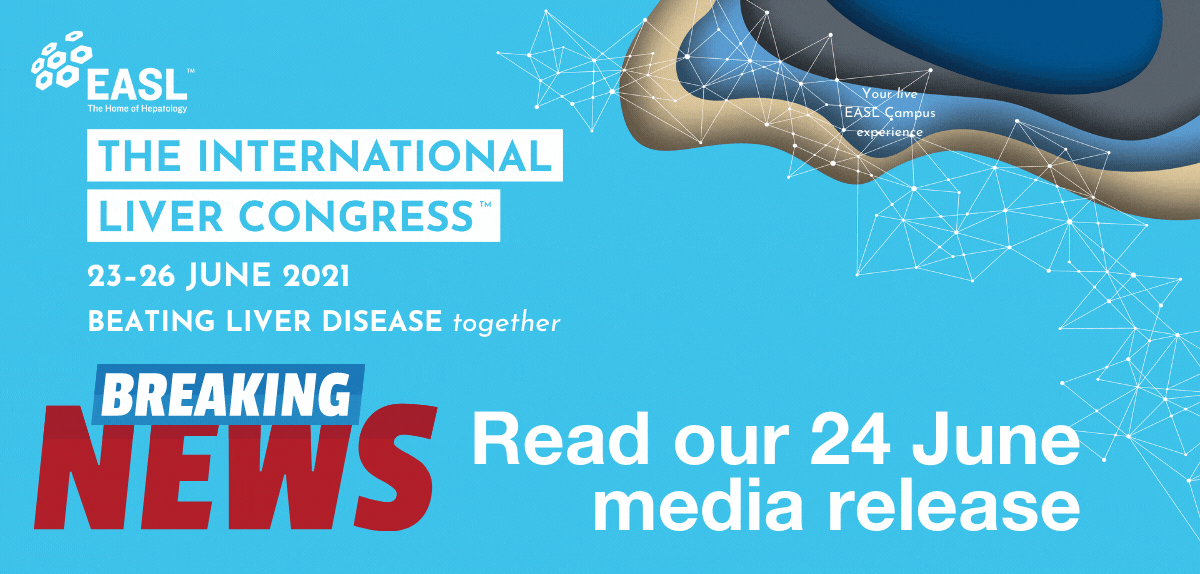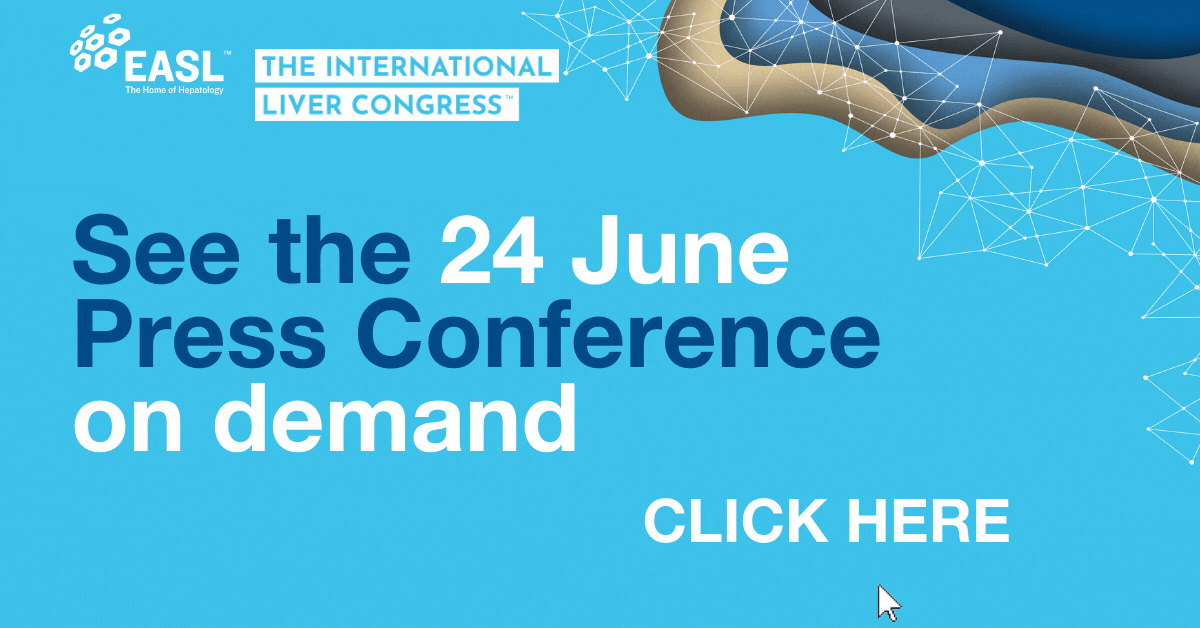Advances in new drugs to for curing Hepatitis B and Hepatitis D announced at ILC 2021

For Immediate Release
Media Release
Advances in new drugs to for curing Hepatitis B and Hepatitis D announced at ILC 2021
Thursday 24 June 2021 (Geneva, Switzerland)– Leading hepatology researchers announced important new developments in hepatitis research at the International Liver Congress 2021 today. This includes new data on antivirals to cure Hepatitis B and Hepatitis D and the application of infusion chemotherapy with P-1 inhibitors to treat liver cancer.
Other announcements included a review of the impact of the COVID-19 pandemic on efforts to eliminate Hepatitis C in the USA and some encouraging data from a trial of a new liver dialysis device to treat acute on chronic liver failure (ACLF).
“Scientists and advocates have long argued that if we are realistically going to eliminate Hepatitis B, then we will need a functional cure,” said Philip Newsome, Secretary General of EASL and Professor of Experimental Hepatology and Director of the Centre for Liver Research at the University of Birmingham in the UK. “The results from the trial of RNAi therapeutic drug VIR-2218 are an encouraging example that a cure is possible sooner than later with potential real-world implications for the 300 million people living with the disease.”
Each year 30 million people become newly infected with Hepatitis B and an estimated 884,000 people die each year from the disease and related complications such as liver cancer.
Today’s official press conference highlighted five studies covering treatment and cure research for hepatitis and acute on chronic liver failure selected from over 1500 abstracts being presented at ILC 2021.
Impact of COVID-19 on eliminating Hepatitis (HCV) in the U.S.
As of 2019, the United States (US) was not on track to achieve the WHO targets for elimination, due to increasing incidence and barriers to treatment. In 2020, the COVID-19 pandemic disrupted HCV services globally, with 25 per cent fewer patients being initiated on treatment than in 2019.
Researchers updated a previously validated Markov model to estimate HCV-related morbidity and mortality in the US. Three scenarios were developed to bookend possible outcomes for HCV recovery in the wake of the pandemic. These included 1) long-term treatment disruptions; 2) return to pre-COVID-19 treatment forecasts; 3) Achieve WHO targets through increased treatment and harm reduction.
Sarah Blach of the CDA Foundation in the U.S. reported that From 2014-2019, ~1.2 million patients were treated for HCV, leading to >50% reduction in hepatocellular carcinoma (HCC) cases and >65% reduction in HCV liver-related deaths (LRDs) in 2019 relative to 2014. In the modeled scenarios, between 780,000 and 2.3 million patients (cumulative) would be initiated on treatment from 2021-2030. WHO Targets (scenario 3) could be achieved in the US by treating at least 240,000 patients per year and increasing access to harm reduction programs. Compared to scenario 1, scenarios 2 and 3 could avert 19,400 LRDs and 9,500 HCC cases and 33,200 LRDs and 24,900 HCC cases, respectively.
Abstract: Modelling HCV elimination recovery following the COVID-19 pandemic in the United States: Pathways to regain progress (LBP-2814)
RNAi therapeutic antiviral drug VIR-2218 shows promise in participants with chronic hepatitis B infection
VIR-2218 is an investigational GalNAc-conjugated small interfering ribonucleic acid (siRNA) therapeutic in development for functional cure of chronic hepatitis B virus infection (CHB). VIR-2218 was created using Enhanced Stabilization Chemistry Plus, which retains in vivo potency while reducing off-target effects. VIR-2218 targets a conserved region of the X gene and is designed to silence all major HBV transcripts, from both cccDNA and integrated DNA, across all 10 HBV genotypes as a single siRNA.
Ed Gane of the University of Auckland in New Zealand reported on the that two doses of VIR-2218 at 20-200 mg given 4 weeks apart were well tolerated in CHB participants. Substantial reductions in HBsAg were observed in both HBeAg- and HBeAg+ participants across all dose levels, suggesting that VIR-2218 may silence transcripts from both cccDNA and integrated DNA. The antiviral activity of VIR-2218 demonstrated in this study support continued development as part of combination regimens targeting functional cure.
Abstract: Safety and antiviral activity of VIR-2218, an X-targeting RNAi therapeutic, in participants with chronic hepatitis B infection: week 48 follow-up results (OA-44 )
Session: Friday June 25, 14:00-15:30 CET
Encouraging interim data from Phase III trial of antiviral drug Bulevirtide monotherapy in patients with chronic hepatitis delta
Bulevirtide (BLV) is a first-in-class entry inhibitor for the treatment of chronic hepatitis D virus (HDV) infection. BLV has shown pronounced virological and biochemical responses (HDV RNA and ALT declines) in two phase 2 trials (MYR202/MYR203). This study presented encouraging data from a predefined 24 weeks interim analysis of the MYR301 phase 3 study in HBV/HDV co-infected patients receiving 2mg/qd or 10mg/qd dose BLV monotherapy in comparison to observation with no antiviral treatment (a total of 150 patients).
Heiner Wedemeyer of the Hannover Medical Hospital in Germany noted that after 24 weeks of study,
this phase 3 trial confirms that monotherapy with BLV is safe and well tolerated in patients with compensated hepatitis delta. 24 weeks of treatment with BLV was associated with significant HDV RNA declines and improvements in biochemical disease activity. He concluded that these findings further support the conditional approval of BLV.
Abstract: Bulevirtide monotherapy at low and high dose in patients with chronic hepatitis delta: 24 weeks interim data of the phase 3 MYR301 study (LBP-2730)
Infusion chemotherapy combined with sintilimab may help cure liver cancer
This study aimed to explore the efficacy and safety of Hepatic arterial infusion chemotherapy in combination with sintilimab (a PD-1 inhibitor) in locally advanced, potentially resectable HCC. A total of 30 patients were enrolled with median age of 50.5 years (range 34-70), 93.3% male, and 96.7% HBV-infected. The median treatment cycle was 2 years.
Tumour evaluation was performed every 6-8 weeks. Pts with tumour reduction and eligible for R0 resection were referred for hepatectomy, then continued with sintilimab monotherapy to at most 16 courses. Primary endpoint was progression free survival (PFS) per RECIST 1.1 defined as time from the first day of treatment to disease progression or postoperative relapse or death
Li Xu of the Sun Yat-sen University Cancer Center in China explained that as of April 2021, 29 patients had been evaluated regularly with median follow-up time of 17.1 months (range: 6.5-25.6). Median PFS and OS were not reached, and 12 months PFS and OS rates were 57.6% (95%CI 41.9-79.2) and 82.3% (95%CI 69.4-97.1), respectively. ORR and DCR were 44.8% (13/29) and 75.9% (22/29). 19 (65.5%) pts received hepatectomy with 3 pathologic complete response (pCR). Another 2 pts with deep response received radical ablation, and 1 was confirmed pCR by needle biopsy. 14 patients remain tumour free so far. Most treatment related AEs (TRAE) were grade 1-2, the most common AEs were pyrexia (10%), rash (10%) and pruritus (10%). Only 1 patient experienced reversible immune-related liver dysfunction of grade 4. No other grade 3-5 TRAE or SAE was observed.
Hepatic arterial infusion chemotherapy in combination with THE PD-1 inhibitor showed a high conversion rate and good safety profile. The combined strategy may be considered as an optimal treatment choice to provide a chance of cure in locally advanced and potentially resectable HCC.
Abstract: Hepatic arterial infusion chemotherapy in combination with PD-1 inhibitor as a conversion therapy in locally advanced, potentially resectable hepatocellular carcinoma: A Phase II study (OA- 2679)
Session: Friday June 25, 14:00-15:30
Novel liver dialysis device shows encouraging preliminary results in addressing acute on chronic liver failure (ACLF)
Treatment of acute on chronic liver failure (ACLF) is an unmet need. Currently, standard of care (SOC) involves treating infections with antibiotics and supporting individual organs, dialysis for kidney failure and pressors for low blood pressure. There are very few disease modifying options at present; steroids may have a role in some liver conditions but a large proportion of patients are non-responders to steroids, and steroids come with the inherent risk of new infections. Liver transplant is an option but is not available in the UK for many of these patients.
This randomised study tests the hypothesis that DIALIVE, a novel liver dialysis device ,will significantly improve the prognosis of ACLF patients. The primary end point was safety; device performance; clinical and pathophysiologic effects. DIALIVE principally replaces dysfunctional albumin and removes pathogen and damage associated molecular patterns.
32-ACLF patients with alcoholic cirrhosis were randomised either to DIALIVE or SOC. A minimum of 3 DIALIVE sessions (max 5) were needed for the patient to be evaluable. The trial was conducted in patients who presented in intensive care units with an acute flare of their chronic liver disease, which rapidly progressed to a severe additional worsening of the liver function and failure of a combination of other important organs such as kidneys, brain and lungs.
Banwari Agarwal of the Royal Free Hospital in UK noted that while the number of the patients studied is relatively small, the data so far points to a very strong signal suggesting that the patients treated with Dialive were significantly more likely to recover from this acute flare and return to the pre-illness levels of liver and other organ function. DIALIVE is safe and significantly increases proportion of patients resolving ACLF whilst reducing time to resolution. The data justify start of late phase clinical trials.
Agarwal added that the main advantages of Dialive were two-fold: a) it is relatively simple to assemble and takes advantage of equipment already in use in ICUs, and b) it targets two important pathobiological mechanisms known to trigger acute decline in liver function and associated other organs failure, namely the patient’s own damaged albumin and development of an intense systemic inflammatory response.
Abstract: A multi-centre, randomized controlled study, to evaluate the safety and performance of the DIALIVE Liver Dialysis Device in patients with Acute on Chronic Liver Failure (ACLF) versus standard of care (SOC). (OA-1997)
Session: Thursday June 24, 16:00-17:30 CET.
Further information
Media Registration: Accredited media can apply for free registration here:
Press Programme: The Official Press Programme can be found here:
All ILC 2021 Official Press Conferences will broadcast live on Zoom for registered media.
Embargo Policy: Please note that the ILC2021 Embargo Policy has changed this edition -media representatives are asked to familiarise themselves with the new policy.
Contact:
Michael Kessler
Michael Kessler Media
EASL Media Relations
Email: michael.kessler@intoon-media.com
Mob: +34 655 792 699
Twitter: @mickessler
About The International Liver Congress™
This annual congress is EASL’s flagship event, attracting scientific and medical experts from around the world to learn about the latest in liver research and exchange clinical experience. Attending specialists present, share, debate and conclude on the latest science and research in hepatology, working to enhance the treatment and management of liver disease in clinical practice. This year, the congress is being held entirely digitally due to the global health situation.
About The European Association for the Study of the Liver (EASL)
Since its foundation in 1966, this not-for-profit organisation has grown to over 4,500 members from all over the world, including many of the leading hepatologists in Europe and beyond. EASL is the leading liver association in Europe, having evolved into a major European association with international influence, and with an impressive track record in promoting research in liver disease, supporting wider education, and promoting changes in European liver policy.


